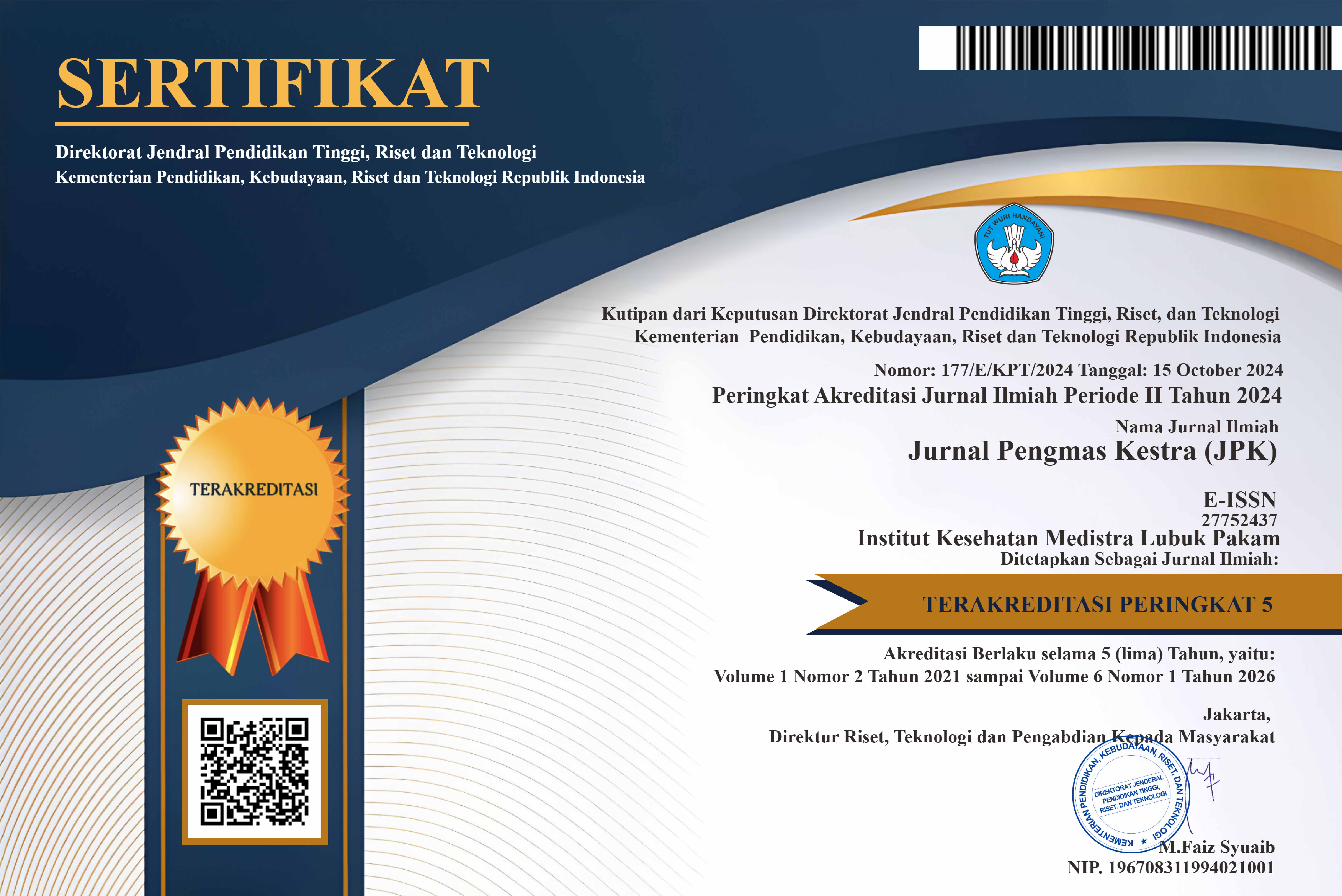Optimizing the Implementation of Foot Massage as an Effort to Increase Comfort and Reduce Pain After Labor
DOI:
https://doi.org/10.35451/jpk.v4i1.2177Keywords:
Optimazation; Foot Massage; Pain;Comfort; postpartumAbstract
Childbirth is a maternal experience that often results in trauma for the mother. Pain before and after delivery is one of the factors that makes the mother uncomfortable. The mother's discomfort will make the mother stressed and will not make the mother comfortable with her new assignment. Foot massage is one method that can be applied to postpartum mothers to reduce the pain and comfort experienced by most mothers in the early postnatal period. Comfort during postpartum will improve the mother's quality of life. The location of the service activity was at the Nining Independent Midwife Practice, Deli Serdang Regency with a total of 14 participants. The target of this activity is postpartum mothers and mothers' companions during treatment. The activity methods used are lectures, role plays and simulations. The activity was carried out twice, namely on 16 and 23 May 2024. The activity consisted of preparation, implementation and evaluation. The results of this service show that most of the participants were >35 years old, female and had a high school education. There is a change in knowledge regarding optimizing foot massage to reduce pain and comfort after childbirth. Before being given health education, the majority of participants had knowledge, namely less than 78.57% and those who had sufficient knowledge were 21.42%. After being given education, the majority of participants had good knowledge about foot massage (57.14%) and 4 participants (28.57%) had good knowledge about foot massage. The presentation of increased knowledge after being given health education was 78.57%. It is hoped that foot massage education can be optimally implemented for postpartum mothers during the postpartum period so that it can help mothers reduce the pain and discomfort that occurs during the postpartum care period.
References
Anbari, K., Ghanadi, P., & Bagheri, A. H. (2022). An investigation into the health-promoting behaviors and their associated factors in 18-29 year-old youth of Khorramabad city in 2020. Journal of Biological Research-Bollettino della Società Italiana di Biologia Sperimentale, 95(2).
Baljon, K., Romli, M. H., Ismail, A. H., Khuan, L., & Chew, B. H. (2022). Effectiveness of breathing exercises, foot reflexology and massage (BRM) on maternal and newborn outcomes among primigravidae in Saudi Arabia: a randomized controlled trial. International Journal of Women's Health, 279-295.
Greaves, L., & Hemsing, N. (2020). Sex and gender interactions on the use and impact of recreational cannabis. International journal of environmental research and public health, 17(2), 509.
Halvorsen, K, et al.(2020). Empowerment in healthcare: A thematic synthesis and critical discussion of concept analyses of empowerment. Patient education and counseling, 103(7), 1263-1271.
Kaplan, E. & Cevik, S.(2021).The effect of guided imagery and reflexology on pain intensity, duration of labor and birth satisfaction in primiparas: Randomized controlled trial. Health Care Women Int. 42, 691–709.(2021).
Lassander, M., Hintsanen, M., Suominen, S., Mullola, S., Vahlberg, T., & Volanen, S. M. (2021). Effects of school-based mindfulness intervention on health-related quality of life: moderating effect of gender, grade, and independent practice in cluster randomized controlled trial. Quality of Life Research, 30(12), 3407-3419.
Liu, L., Qian, X., Chen, Z., & He, T. (2020). Health literacy and its effect on chronic disease prevention: evidence from China’s data. BMC public health, 20, 1-14.
Moghimi-Hanjani, S., Mehdizadeh-Tourzani, Z., & Shoghi, M. (2015). The effect of foot reflexology on anxiety, pain, and outcomes of the labor in primigravida women. Acta Medica Iranica, 507-511.
Navaee, M., Khayat, S., & Abed, Z. G. (2020). Effect of pre-cesarean foot reflexology massage on anxiety of primiparous women. Journal of Complementary and Integrative Medicine, 17(3).
Nanji, J. A., & Carvalho, B. (2020). Pain management during labor and vaginal birth. Best Practice & Research Clinical Obstetrics & Gynaecology, 67, 100-112.
?olt Kirca, A., & Kanza Gul, D. (2020). The effect of acupressure applied to points LV4 and LI4 on perceived acute postpartum perineal pain after vaginal birth with episiotomy: a randomized controlled study. Archives of gynecology and obstetrics, 301, 473-481.
Stellefson, M., Paige, S. R., Chaney, B. H., & Chaney, J. D. (2020). Evolving role of social media in health promotion: updated responsibilities for health education specialists. International journal of environmental research and public health, 17(4), 1153.
Yang, J. M., Li, Z. Q., Ye, H., Wu, Y. L., Long, Y., Zhong, Y. B., ... & Wang, M. Y. (2024). Effects of foot reflexology massage on pregnant women: a systematic review and meta-analysis of randomized controlled studies. Scientific Reports, 14(1), 1012
Y?lar Erkek, Z., & Aktas, S. (2018). The effect of foot reflexology on the anxiety levels of women in labor. The Journal of Alternative and Complementary Medicine, 24(4), 352-360.
Downloads
Published
Issue
Section
License
Copyright (c) 2024 Diah Evawanna Anuhgera, Nikmah Jalila Ritonga, Astri Ulina Saragih, Damayanti

This work is licensed under a Creative Commons Attribution 4.0 International License.
Copyright in each article is the property of the Author.




















